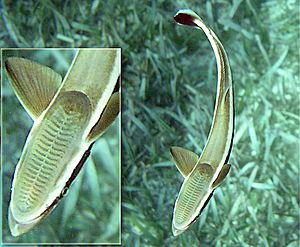Live sharksucker facts for kids
Quick facts for kids Live sharksucker |
|
|---|---|
 |
|
| Conservation status | |
| Scientific classification | |
| Genus: |
Echeneis
|
| Species: |
naucrates
|
| Synonyms | |
|
|
The live sharksucker (also known as the slender sharksucker) is a fascinating marine fish. It belongs to a special group of fish called remoras. Remoras are known for their unique way of attaching to other animals. Its scientific name is Echeneis naucrates.
Contents
Where Sharksuckers Live
Global Ocean Homes
This fish lives in tropical and warm waters all around the world. You can find them almost everywhere except the eastern Pacific Ocean. They live both near the coast and far out in the open ocean. Sharksuckers can be found at depths up to 50 meters (about 164 feet).
Attaching to Hosts
Sharksuckers are famous for temporarily attaching themselves to different objects or larger animals. They use a special sucking disc on their heads. These larger animals are called hosts.
They can attach to many kinds of hosts, including:
- sharks
- rays
- Large bony fishes
- sea turtles
- whales
- dolphins
- Even ships and scuba divers!
What Sharksuckers Look Like
Size and Body Shape
The live sharksucker is a medium-sized fish. It can grow up to 110 centimeters (about 43 inches) long. Its body is long and smooth, perfect for swimming. Its lower jaw sticks out clearly past its upper jaw. This is called being prognathic. The jaws, roof of the mouth, and tongue all have small, brush-like teeth. These are called villiform teeth.
The Sucking Disc
The most special part of the sharksucker is its oval-shaped sucking disc. This disc is actually a changed dorsal fin. It sits on top of the fish's head and extends down its back. This disc is what allows the sharksucker to stick to its hosts.
Colors and Markings
The body of the sharksucker is usually dark grey to dark brown. Its belly is dark. A dark stripe runs along the side of its body. This stripe is always darker than the rest of its body and has a whitish edge. The tail fin is black with white corners.
What Sharksuckers Eat
Changing Diets
What a remora eats depends on its age and if it's attached to a host or not.
Young Sharksuckers
When they are young, sharksuckers sometimes act like cleaner fish. They go to special spots on coral reefs called cleaning stations. Here, they eat tiny parasitic crustaceans. These small creatures include things like copepods, isopods, and ostracods.
Eating with a Host
When a sharksucker is attached to a host, its diet changes. It eats parasitic crustaceans from its host. It also eats food scraps that fall from its host's meals. Sometimes, it even catches small food by filtering water through its brush-like teeth.
Eating Without a Host
If the sharksucker is not attached to a host, it stays closer to the shore. It might gather with other sharksuckers. Then, its diet includes free-living crustaceans, squid, and small fish.



